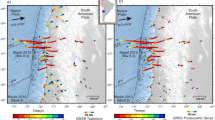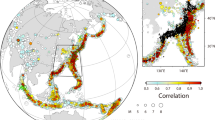Abstract
The Mw 8.8 mega-thrust earthquake and tsunami that occurred on 27 February 2010 offshore the Maule region, Chile, was not unexpected. A clearly identified seismic gap1,2,3,4,5,6,7,8,9,10,11,12,13 existed in an area where tectonic loading has been accumulating since the great 1835 earthquake14. Here we jointly invert tsunami and geodetic data to derive a robust model for the coseismic slip distribution and induced coseismic stress changes. We compare these with past earthquakes and the preseismic locking distribution13, to assess if the Maule earthquake has filled the seismic gap. We find that the main slip patch is located to the north of the gap, overlapping the rupture zone of the Mw 8.0 earthquake that occurred in 1928, with a secondary concentration of slip to the south. The seismic gap was only partially filled and a zone of high preseismic locking remains unbroken, inconsistent with the assumption that distributions of seismic rupture might be correlated with preseismic locking. Moreover, we conclude that increased stress on the unbroken patch may in turn have increased the probability of another major to great earthquake there in the near future.
This is a preview of subscription content, access via your institution
Access options
Subscribe to this journal
Receive 12 print issues and online access
$259.00 per year
only $21.58 per issue
Buy this article
- Purchase on Springer Link
- Instant access to full article PDF
Prices may be subject to local taxes which are calculated during checkout




Similar content being viewed by others
Change history
08 February 2011
In the version of this Letter originally published online, the y-axis values and label were missing from Fig. 3c. This error has now been corrected in all versions of the Letter.
References
Barrientos, S. Is the Pichilemu–Talcahuano (Chile) a seismic gap? Seismol. Res. Lett. 61, 43 (1990).
Campos, J. & Kausel, E. The large 1939 intraplate earthquake of Southern Chile. Seismol. Res. Lett. 61, 43 (1990).
Madariaga, R. La Seismicidad de Chile, Fisica de la Tierra, Vol. 10 221–258 (Ediciones de la Universidad Complutense de Madrid, 1998).
Beck, S., Barrientos, S., Kausel, E. & Reyes, M. Source characteristics of historic earthquakes along the central Chile subduction zone. J. South Am. Earth Sci. 11, 115–129 (1998).
Klotz, J. et al. Earthquake cycle dominates contemporary crustal deformation in Central and Southern Andes. Earth Planet. Sci. Lett. 193, 437–446 (2001).
Ruegg, J. C. et al. Interseismic strain accumulation in south central Chile from GPS measurements, 1996–1999. Geophys. Res. Lett. 29, 1517–1520 (2002).
Campos, J. et al. A seismological study of the 1835 seismic gap in South Central Chile. Phys. Earth Planet. Iner. 132, 177–195 (2002).
Brooks, B. A. et al. Crustal motion in the Southern Andes (26°–36° S): Do the Andes behave like a microplate? Geochem. Geophys. Geosyst. 4, 1085 (2003).
Moreno, M. S., Klotz, J., Melnick, D, Echtler, H. & Bataille, K. Active faulting and heterogeneous deformation across a megathrust segment boundary from GPS data, south central Chile (36–39° S). Geochem. Geophys. Geosyst. 9, Q12024 (2008).
Vigny, C. et al. Upper plate deformation measured by GPS in the Coquimbo Gap, Chile. Phys. Earth Planet. Iner. 175, 86–95 (2009).
Ruegg, J. C. et al. Interseismic strain accumulation measured by GPS in the seismic gap between Constitución and Concepción in Chile. Phys. Earth Planet. Iner. 175, 78–85 (2009).
Madariaga, R., Métois, M., Vigny, C. & Campos, J. Central chile finally breaks. Science 328, 181–182 (2010).
Moreno, M., Rosenau, M. & Oncken, O. 2010 Maule earthquake slip correlates with pre-seismic locking of Andean subduction zone. Nature 467, 198–204 (2010).
Darwin, C. Journal of the Researches into the Natural History and Geology of the Countries Visited During the Voyage of the HMS Beagle Round the World 2nd edn (John Murray, 1845).
Farı´as, M. et al. Land-level changes produced by the Mw 8.8 2010 Chilean earthquake. Science 329, 916 (2010).
Delouis, B., Nocquet, J-M. & Vallée, M. Slip distribution of the February 27, 2010 Mw=8.8 Maule earthquake, central Chile, from static and high-rate GPS, InSAR, and broadband teleseismic data. Geophys. Res. Lett. 37, L17305 (2010).
Tong, X. et al. The 2010 Maule, Chile earthquake: Downdip rupture limit revealed by space geodesy. Geophys. Res. Lett. 37, L24311 (2010).
Lay, T. et al. Teleseismic inversion for rupture process of the 27 February 2010 Chile (Mw 8.8) earthquake. Geophys. Res. Lett. 37, L13301 (2010).
Moreno, M. S., Bolte, J., Klotz, J. & Melnick, D. Impact of megathrust geometry on inversion of coseismic slip from geodetic data: Application to the 1960 Chile earthquake. Geophys. Res. Lett. 36, L16310 (2009).
Konca, O. et al. Partial rupture of a locked patch of the Sumatra megathrust during the 2007 earthquake sequence. Nature 456, 631–635 (2008).
Bilek, S. L. The role of subduction erosion on seismicity. Geology 38, 479–480 (2010).
Nalbant, S. S., Steacy, S., Sieh, K., Natawidjaja, D. & McCloskey, J. Earthquake risk on the Sunda trench. Nature 435, 756–757 (2005).
Lichten, S. & Borders, J. Strategies for high-precision Global Positioning System orbit determination. J. Geophys. Res. 92, 12751–12762 (1987).
D’Agostino, N. et al. Active tectonics of the adriatic region from GPS and earthquake slip vectors. J. Geophys. Res. 113, B12413 (2008).
Altamimi, Z., Collilieux, X., Legrand, J., Garayt, B. & Boucher, C. ITRF2005: A new release of the international terrestrial reference frame based on time series of station positions and earth orientation parameters. J. Geophys. Res. 112, B09401 (2007).
Bird, P. An updated digital model of plate boundaries. Geochem. Geophys. Geosyst. 4, 1027 (2003).
Okada, Y. Surface deformation due to shear and tensile faults in a half-space. Bull. Seismol. Soc. Am. 75, 1135–1154 (1985).
Lorito, S., Piatanesi, A., Cannelli, V., Romano, F. & Melini, D. Kinematics and source zone properties of the 2004 Sumatra–Andaman earthquake and tsunami: Nonlinear joint inversion of tide gauge, satellite altimetry, and GPS data. J. Geophys. Res. 115, B02304 (2010).
Lin, J. & Stein, R. S. Stress triggering in thrust and subduction earthquakes, and stress interaction between the southern San Andreas and nearby thrust and strike-slip faults. J. Geophys. Res. 109, B02303 (2004).
Toda, S., Stein, R. S., Richards-Dinger, K. & Bozkurt, S. Forecasting the evolution of seismicity in southern California: Animations built on earthquake stress transfer. J. Geophys. Res. 110, B05S16 (2005).
Acknowledgements
We acknowledge discussions with our colleagues E. Tinti and A. Herrero about seismic rupture properties, and with S. Nalbant about coseismic stress. We also acknowledge C. Vigny, leader for the acquisition of the GPSCOPE GPS data in Chile. We thank N. D’Agostino and E. D’Anastasio, who set up and implemented the GPS data processing strategy. We appreciate the effort of our colleagues at Cornell University who developed the tsunami-modelling package. We moreover wish to thank all of the data providers who made this study possible. Some figures were drawn with generic mapping tools (http://gmt.soest.hawaii.edu/). J.M. acknowledges support from the UK NERC under grant numbers NE/F01161X/1 and NE/H008519/1.
Author information
Authors and Affiliations
Contributions
S.L., F.R. and A.P. were involved in all of the phases of this study. S.A., X.T. and A.A. processed, modelled and analysed geodetic data, and wrote part of the Methods. J.M. and M.C. contributed to result interpretation and paper writing. E.B. promoted the experiment, contributed to result interpretation and supported the project.
Corresponding author
Ethics declarations
Competing interests
The authors declare no competing financial interests.
Supplementary information
Supplementary Information
Supplementary Information (PDF 1683 kb)
Rights and permissions
About this article
Cite this article
Lorito, S., Romano, F., Atzori, S. et al. Limited overlap between the seismic gap and coseismic slip of the great 2010 Chile earthquake. Nature Geosci 4, 173–177 (2011). https://doi.org/10.1038/ngeo1073
Received:
Accepted:
Published:
Issue Date:
DOI: https://doi.org/10.1038/ngeo1073
This article is cited by
-
Central shutdown and surrounding activation of aftershocks from megathrust earthquake stress transfer
Nature Geoscience (2022)
-
Quadratic Stress Drop Model of the 2013 Mw 6.6 Lushan Earthquake and Aftershocks Triggered by Blind Thrust Events
Pure and Applied Geophysics (2022)
-
Postseismic geodetic signature of cold forearc mantle in subduction zones
Nature Geoscience (2021)
-
Regional seismic damage analysis considering soil–structure cluster interaction using lumped parameter models: a case study of Sichuan University Wangjiang Campus buildings
Bulletin of Earthquake Engineering (2021)
-
Toward comparable relative locations between the mainshock slip and aftershocks via empirical approaches
Earth, Planets and Space (2020)



